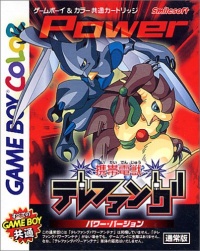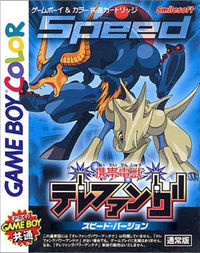Telefang 1: Difference between revisions
No edit summary |
Blaziken257 (talk | contribs) |
||
| Line 26: | Line 26: | ||
* There are different Denjuu appearances in the two versions. | * There are different Denjuu appearances in the two versions. | ||
* There are some colour differences in the two such as the colour of the [[D-Shoot]] menu. | * There are some colour differences in the two such as the colour of the [[D-Shoot]] menu. | ||
* In | * In [[Paparuna Lake]], the order of houses one is required to enter to solve the puzzle is different in Power version than that in Speed version. | ||
==Sequel== | ==Sequel== | ||
Revision as of 16:18, 25 February 2008
| Telefang 1 | |
 
| |
| Developer(s) | Smilesoft |
|---|---|
| Publisher(s) | Natsume |
| Designer(s) | Takagi Toushi |
| Release date | 3 November 2000 |
| Genre | Console role-playing game |
| Platform | [[wikipedia:Game Boy Color|Game Boy Color]] |
- For the second version of Keitai Denjū Telefang, see Keitai Denjū Telefang 2.
Keitai Denjū Telefang (Japanese: 携帯電獣テレファング; Romaji: Keitai Denjyuu Terefangu) is a video game for Game Boy Color released by Smilesoft in Japan. It is available in two versions, namely Power version and Speed version.
The name
Keitai means mobile in Japanese, while Den means electric, jū means monster, and Telefang is a English word in Katakana to mean something like Telephone Fangs (Fangs as in monsters).[1]
Version differences
The two versions, Power and Speed, have some differences:
- In Power version, the starter partner you will have is Krypto but in Speed version it is Fangs.
- There are different Denjuu appearances in the two versions.
- There are some colour differences in the two such as the colour of the D-Shoot menu.
- In Paparuna Lake, the order of houses one is required to enter to solve the puzzle is different in Power version than that in Speed version.
Sequel
- Main article: Keitai Denjū Telefang 2
Smilesoft released a sequel to Keitai Denjū Telefang for the Game Boy Advance, with new Denjū appearances and a slightly different style of battle, where the player can intervene in a middle of a battle to use items on the Denjū. Move types were also introduced.
The sprites were also redrawn, and had better graphics and music.
Bootleg
- Main article: Pokemon Diamond and Jade
Keitai Denjū Telefang was originally only available in Japanese. However, pirates in China bootlegged it under the name of Pokémon Diamond and Pokémon Jade. [1] Their attempt was not very good, as the English is poor with some profanities included.
The sprites and maps remain the same, just that it is English. The ability to name the character or the Denjuu was also not present, and the game would also not load a save properly.
See also
Refences
- ↑ Jump up to: 1.0 1.1 http://en.wikipedia.org/wiki/Keitai_Denjuu_Telefang. Accessed on 13 January 2008.